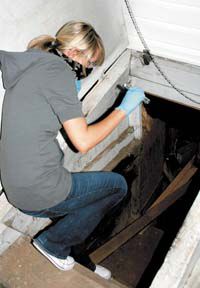| A local resident slips down into her cellar to put away some summer fare. Area health officials are reminding Carbon County residents that hantavirus can be contracted in the fall as well as in the spring during cleanup. |
The threat of hantavirus pulmonary syndrome usually accompanies the arrival of spring.
However, local officials at the Southeastern Utah Health District in Price warn residents in the Carbon County area that the threat of contracting the potentially fatal disease can occur during fall cleanup efforts as well.
Hantavirus pulmonary syndrome is a potentially deadly lung disease contracted by humans coming into direct contact with infected rodents or the animal’s urine or droppings.
Hantavirus pulmonary syndrome was first identified in 1993 and has since been recognized at locations throughout the United States.
Rodent control in and around the home remains the primary strategy for preventing hantavirus infection.
“The number one precaution to be taken for warding off hantavirus is to make sure that all sheds, campers and the like are well sealed,” said SEUDHD official Claron Bjork. “If you can keep mice out you can keep the disease away.”
Bjork recommended using duct tape if necessary to ensure that rodents can’t get into storage or dormant facilities.
“If you can get a pencil through an opening in anything, then a mouse can get in,” warned Bjork.
Bjork indicated that it is not the number of rodents in a given community that leads to increased danger from hantavirus.
“We had a very high rodent population within the state this year,” said Bjork. “But very low numbers of hantavirus.”
An outbreak of unexplained illness occurred in May 1993 in the Four Corners area shared by Utah, New Mexico, Arizona and Colorado.
A number of previously healthy young adults suddenly developed acute respriatory symptoms and half of the victims died, according to the Utah Department of Health.
Health department researchers suspected a form of hantavirus. And as the disease is transmitted by rodents, the researchers trapped vermin in the affected area.
The trapping method results led local authorities to identify the virus along with its principal carrier, the deer mouse.
It was also made public that the virus had been present but unrecognized as early as 1959.
Earlier cases of hantavirus pulmonary syndrome have been identified by examining samples of tissue belonging to people who died of unexplained adult respiratory distress syndrome.
By applying the tissue examination method, researchers have determined that the earliest confirmed case of HPS involved a 38-year-old man in 1959.
“Interestingly, while HPS was not known to the epidemiological and medical communities, there is evidence that it was recognized elsewhere. The Navajo Indians, a number of whom contracted HPS during the 1993 outbreak, recognized a similar disease in their medical traditions and actually associated its occurrence with mice,” pointed out state public health officials.
It is important for people to remember, according to state health officials, that not all rodents carry hantavirus.
However, it is better for people to err on the side of caution and assume the rodent in question is a hantavirus carrier, pointed out the public health officials.
Droppings are the most reliable signs of a rodent problem.
According to the local health district, rodents build nests from soft, fuzzy or warm materials.
Common nesting materials included shredded paper, dry grass or small twigs, fabric and furniture stuffing.
Rodents prefer places that are relatively quiet. The animals lurch inside cabinets, under or inside dressers, among boxes, behind appliances, inside upholstered furniture and inside double walls.
The SEUDHD reported that avoiding contact with any rodent species is the only sure prevention for the deadly disease.
“If you must be around rodents and their droppings while cleaning this fall citizens should take the following precautions,” said SEUDHD officials.
The following information is also good for all purpose winter home preparation and rodent removal:
•Local residents should rovide good ventilation to the areas being cleaned.
•People should seal, screen or cover all openings into the home one- quarter of an inch or larger.
•Residents should set spring loaded mouse traps inside the home.
•People should wear rubber or plastic gloves while handling rodents.
•Residents should place rodent carcasses in plastic bags containing a general purpose household disinfectant.
•People should wash gloved hands in general household disinfectant and then in soap and water.
Local residents should also wash bare hands after removing gloves.
Symptoms of the hantavirus usually start with a flu-like onset and a fever greater than 100.5, muscle aches and chills.
Other common symptoms are a cough, shortness of breath, nausea and vomiting, diarrhea and headache.
Less common symptoms of hantavirus include dizziness or lightheaded, joint pain, back chest or abdominal pain and sweats.
The only treatment for hantavirus to date is supportive, according to the SEUDHD.
Patients with severe breathing problems are often placed on oxygen and a ventilator.
Rivavirin is an antiviral drug that has been used in the past with other stains of hantavirus.
Due to the limited number of patients, the effectiveness of the drug is virtually unknown, concluded state and local public health officials.

